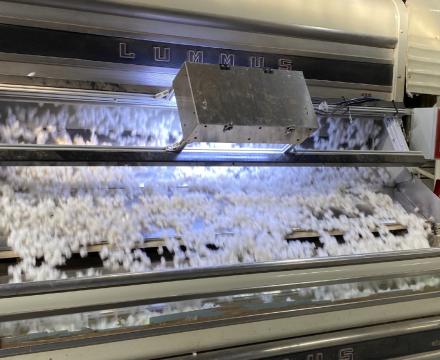It’s a Wrap for the Wrap

Cotton bolls pass through the Visual Inspection and Plastic Removal system during the cotton ginning process. The system uses cameras to detect plastic contamination. (Photo courtesy of Matthew Pelletier)
People have known for centuries about the usefulness, worth, and value of cotton, but one fairly recent innovation – intended to shelter the crop – has actually become an obstacle for the industry.
Farmers frequently wrap their large round cotton bales in plastic to protect them from environmental contaminants as they await transportation from the field to processing plants. While effective, shreds of plastic sometimes break away during the removal process and become entangled with cotton fibers. The resulting contamination leads to machinery damage, processing inefficiencies, and a notable reduction in market value.
Fortunately, new technology created by the Agricultural Research Service (ARS) and industry partners is helping to solve that problem.
According to Matthew Pelletier, agricultural engineer with the ARS Cotton Production and Processing Research unit in Lubbock, TX, the technology leverages color cameras and advanced custom algorithms to identify and eliminate plastic contaminants during ginning. “Ginning” refers to the process of removing stems, burrs, soil, and other debris from cotton bolls.
“The VIPR (Visual Inspection and Plastic Removal) system uses color cameras to rapidly and accurately detect plastic contaminants,” Pelletier said. “We use cell phone technology to reduce the cost and make it economically viable on a large scale. This approach allows us to integrate advanced imaging and processing capabilities at a fraction of the cost of traditional industrial systems.”
Cameras scan for plastic contaminants as cotton enters the ginning process. When detected, precise air knives remove it from the cotton stream. This process eliminates the contamination and minimizes the loss of good cotton.
Plastic contamination has led to significant financial losses for the cotton industry, Pelletier said – more than $750 million annually since the practice of wrapping bales in plastic began. For an average cotton farmer growing 1,500 acres of cotton, plastic-related losses could be more than $30,000 per year.
The VIPR technology team recently won two awards for their efforts: the 2020 Federal Laboratory Consortium for Technology Transfer (FLCTT) Regional Mid-Continent Award and the 2021 FLCTT National Award.
“This technology represents a significant advancement in agricultural technology,” Pelletier said. “It not only aims to restore the international market value and reputation of U.S. cotton, but also has implications for other agricultural or manufacturing sectors that face similar challenges.” – by Scott Elliott, ARS Office of Communications

